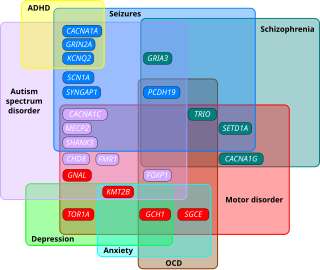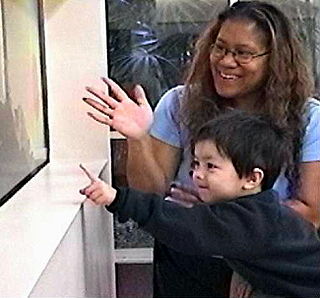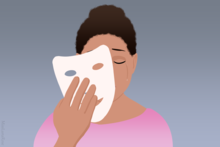
Asperger syndrome (AS), also known as Asperger's syndrome or Asperger's, was a diagnosis used to describe a neurodevelopmental condition characterized by significant difficulties in social interaction and nonverbal communication, along with restricted, repetitive patterns of behavior and interests. Asperger syndrome has been merged with other conditions into autism spectrum disorder (ASD) and is no longer a diagnosis in the WHO's ICD-11 or the APA's DSM-5-TR. It was considered milder than other diagnoses which were merged into ASD due to relatively unimpaired spoken language and intelligence.
Diagnoses of autism have become more frequent since the 1980s, which has led to various controversies about both the cause of autism and the nature of the diagnoses themselves. Whether autism has mainly a genetic or developmental cause, and the degree of coincidence between autism and intellectual disability, are all matters of current scientific controversy as well as inquiry. There is also more sociopolitical debate as to whether autism should be considered a disability on its own.

Autism spectrum disorder (ASD) is a neurodevelopmental disorder that begins in early childhood, persists throughout adulthood, and is characterized by difficulties in social communication and restricted, repetitive patterns of behavior. There are many conditions comorbid to autism spectrum disorder, such as attention deficit hyperactivity disorder, anxiety disorders, and epilepsy.

The neurodiversity paradigm is a framework for understanding human brain function that recognizes the diversity within sensory processing, motor abilities, social comfort, cognition, and focus as neurobiological differences. This diversity falls on a spectrum of neurocognitive differences. The neurodiversity paradigm argues that diversity in neurocognition is part of humanity and that some neurodivergences generally classified as disorders, such as autism, are differences and disabilities that are not necessarily pathological. Neurotypical individuals are those who fall within the average range of functioning and thinking.
Ole Ivar Løvaas was a Norwegian-American clinical psychologist and professor at the University of California, Los Angeles. He is most well known for his research on what is now called applied behavior analysis (ABA) to teach autistic children through prompts, modeling, and positive reinforcement. His application of the science was also noted for its use of aversives (punishment) to reduce undesired behavior, which are no longer supported as a part of most ABA treatment plans.
The following outline is provided as an overview of and topical guide to autism:

Autism therapies include a wide variety of therapies that help people with autism, or their families. Such methods of therapy seek to aid autistic people in dealing with difficulties and increase their functional independence.

Self-stimulatory behavior, also known as "stimming" and self-stimulation, is the repetition of physical movements, sounds, words, moving objects, or other behaviors. Such behaviors are found to some degree in all people, especially those with developmental disabilities such as attention deficit hyperactivity disorder (ADHD) and autism. People diagnosed with sensory processing disorder are also known to potentially exhibit stimming behaviors.
The empathising–systemising (E–S) theory is a theory on the psychological basis of autism and male–female neurological differences originally put forward by clinical psychologist Simon Baron-Cohen. It classifies individuals based on abilities in empathic thinking (E) and systematic thinking (S). It attempts to explain the social and communication symptoms in autism spectrum disorders as deficits and delays in empathy combined with intact or superior systemising.
Social Stories were devised as a tool to help autistic individuals better understand the nuances of interpersonal communication so that they could "interact in an effective and appropriate manner". Although the prescribed format was meant for high functioning people with basic communication skills, the format was adapted substantially to suit individuals with poor communication skills and low level functioning. The evidence shows that there has been minimal improvement in social interaction skills. However, it is difficult to assess whether the concept would have been successful if it had been carried out as designed.

Societal and cultural aspects of autism or sociology of autism come into play with recognition of autism, approaches to its support services and therapies, and how autism affects the definition of personhood. The autistic community is divided primarily into two camps; the autism rights movement and the pathology paradigm. The pathology paradigm advocates for supporting research into therapies, treatments, and/or a cure to help minimize or remove autistic traits, seeing treatment as vital to help individuals with autism, while the neurodiversity movement believes autism should be seen as a different way of being and advocates against a cure and interventions that focus on normalization, seeing it as trying to exterminate autistic people and their individuality. Both are controversial in autism communities and advocacy which has led to significant infighting between these two camps. While the dominant paradigm is the pathology paradigm and is followed largely by autism research and scientific communities, the neurodiversity movement is highly popular among most autistic people, within autism advocacy, autism rights organizations, and related neurodiversity approaches have been rapidly growing and applied in the autism research field in the last few years.

Classic autism, also known as childhood autism, autistic disorder, (early) infantile autism, infantile psychosis, Kanner's autism, Kanner's syndrome, or (formerly) just autism, is a neurodevelopmental condition first described by Leo Kanner in 1943. It is characterized by atypical and impaired development in social interaction and communication as well as restricted, repetitive behaviors, activities, and interests. These symptoms first appear in early childhood and persist throughout life.
Autism, or autism spectrum disorder (ASD), is a neurodevelopmental disorder characterized by repetitive, restricted, and inflexible patterns of behavior, interests, and activities, as well as deficits in social communication and social interaction, and the presence of high or low sensory sensitivity. The underlying spectrum of ASD results in a variety of manifestations and support needs of the disorder. For example, some are nonverbal, while others have proficient spoken language.
Diagnosis, treatment, and experiences of autism varies globally. Although the diagnosis of autism is rising in post-industrial nations, diagnosis rates are much lower in developing nations.
Sex and gender differences in autism exist regarding prevalence, presentation, and diagnosis.
Nonverbal autism, also called nonspeaking autism, is a subset of autism spectrum disorder (ASD) where the person does not learn how to speak. One study has shown that 64% of autistic children who are nonverbal at age 5 are still nonverbal 10 years later.

Autistic masking, also referred to as camouflaging, is the conscious or subconscious suppression of autistic behaviors and compensation of difficulties in social interaction by autistic people with the goal of being perceived as neurotypical. Masking is a learned coping strategy that can be successful from the perspective of autistic people, but can also lead to adverse mental health outcomes.

Current research indicates that autistic people have higher rates of LGBTQ identities and feelings than the general population. A variety of explanations for this have been proposed, such as prenatal hormonal exposure, which has been linked with sexual orientation, gender dysphoria and autism. Alternatively, autistic people may be less reliant on social norms and thus are more open about their orientation or gender identity. A narrative review published in 2016 stated that while various hypotheses have been proposed for an association between autism and gender dysphoria, they lack strong evidence.

The theory of the double empathy problem is a psychological and sociological theory first coined in 2012 by Damian Milton, an autistic autism researcher. This theory proposes that many of the difficulties autistic individuals face when socializing with non-autistic individuals are due, in part, to a lack of mutual understanding between the two groups, meaning that most autistic people struggle to understand and empathize with non-autistic people, whereas most non-autistic people also struggle to understand and empathize with autistic people. This lack of understanding may stem from bidirectional differences in dispositions, and experiences between autistic and non-autistic individuals, but not necessarily an inherent deficiency. Recent studies have shown that most autistic individuals are able to socialize, communicate effectively, empathize well or build good rapport, and display social reciprocity with most other autistic individuals. This theory and subsequent findings challenge the commonly held belief that the social skills of all autistic individuals are inherently and universally impaired across contexts, as well as the theory of "mind-blindness" proposed by prominent autism researcher Simon Baron-Cohen in the mid-1990s, which suggested that empathy and theory of mind are universally impaired in autistic individuals.
The diagnosis of autism is based on a person's reported and directly observed behavior. There are no known biomarkers for autism spectrum conditions that allow for a conclusive diagnosis.











